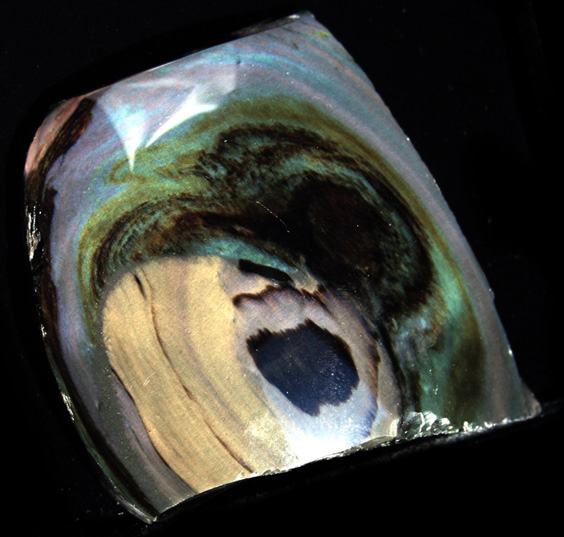Obsidian
Obsidian is a type of glass formed naturally from certain types of volcanic lava flows. It occurs when lava flows which are rich in silica, cool quickly. The nature of the chemical composition of these flows is such that the lava is polymerized and lacks crystalline structure. [1]

Obsidian
Obsidian typically consists of over 70% silicon dioxide - the same mineral as quartz, but its overall composition is complex. It is typically black, although the presence of other mineral ions can create other colors. [1] Obsidian is sometimes seen in other varieties, such as snowflake obsidian, sheen obsidian and rainbow obsidian as depicted in the photo above. Sheen and rainbow obsidian are caused by thin layers of air bubbles trapped inside the rock as it cooled.
Another interesting property of obsidian is that it is metastable. Although at first glance it might appear that this term means the same as "extremely stable" or "ultra stable", it does not. Metastable is a complex term that in this case refers to the fact that obsidian gradually crystallizes over great periods of time. This breakdown is accelerated by water, and no obsidian has been found that predates the Cretaceous period (145.5-65.5 million years ago.) [1] [3]
Obsidian has been carved throughout history and used in ornamental objects, gemstones and jewelry. It has the interesting quality of appearing a different color depending on the direction in which it is cut - and obsidian which is jet black when cut in one direction, may appear grey in another. [1]
In ancient times, obsidian was used to make extremely sharp blades and arrowheads. It is possible to make obsidian blades that are much sharper than is possible with steel - and this has been verified by comparing the sharpest steel and obsidian blades using electron microscopy. Studies have shown that incisions made with obsidian blades may have some superior characteristics (less scarring). [4] Obsidian is still used in the manufacture of certain specialized scalpel blades. [1] [2]
Obsidian Occurrence
Obsidian has been found at several locations on the earth; notably Eastern Antarctica, Armenia, Bolivia, Ethiopia, Greece, Hungary, Iceland, Italy, Japan, Mexico, Slovakia and at several lovations in the south western USA. It's also worth nothing that there has been a proliferation of "gem quality translucent colored obsidian" for sale on the internet in recent years - and that this is said to be artificial and mass produced.[5]

Rainbow Obsidian.
Photo by Mila, released under CC-BY-SA-3.0 license
Obsidian - Sources Referenced:
[1] http://en.wikipedia.org/wiki/Obsidian
[2] http://www.finescience.com/commerce/ccc1065-obsidian-scalpels.htm
[3] http://en.wikipedia.org/wiki/Metastability
[4] http://www.ncbi.nlm.nih.gov/pubmed/8415970
[5] http://www.mindat.org/min-8519.html
Back to the Gemstones List home page - over 160 gemstones explored!
Please feel free to link to this page - copy / paste the text below: (click to select)
Privacy Policy | Cookie Policy | GDPR | About This Site / Terms

© gemstoneslist.com


